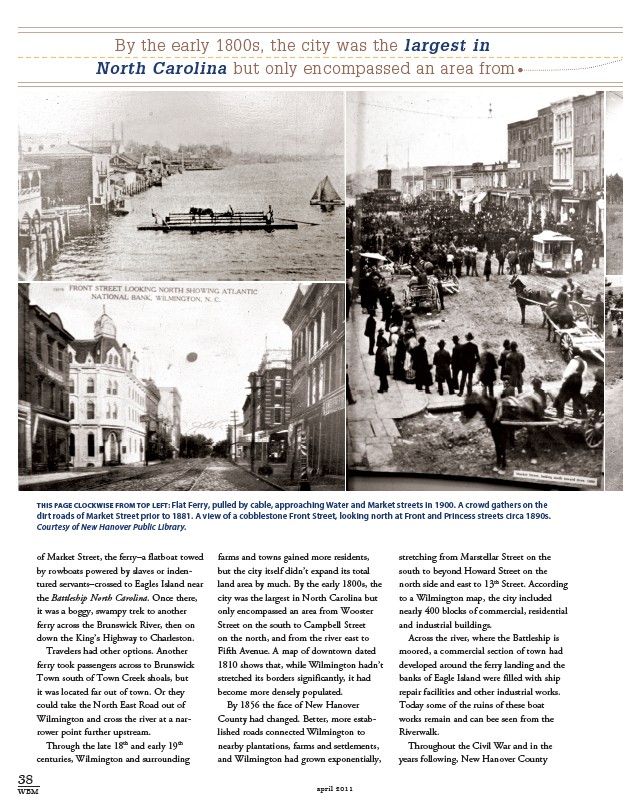
By the early 1800s, the city was the largest in
North Carolina but only encompassed an area from
This page Clockwise from top left: Flat Ferry, pulled by cable, approaching Water and Market streets in 1900. A crowd gathers on the
dirt roads of Market Street prior to 1881. A view of a cobblestone Front Street, looking north at Front and Princess streets circa 1890s.
Courtesy of New Hanover Public Library.
of Market Street, the ferry–a flatboat towed
by rowboats powered by slaves or indentured
servants–crossed to Eagles Island near
the Battleship North Carolina. Once there,
it was a boggy, swampy trek to another
ferry across the Brunswick River, then on
down the King’s Highway to Charleston.
Travelers had other options. Another
ferry took passengers across to Brunswick
Town south of Town Creek shoals, but
it was located far out of town. Or they
could take the North East Road out of
Wilmington and cross the river at a narrower
point further upstream.
Through the late 18th and early 19th
centuries, Wilmington and surrounding
farms and towns gained more residents,
but the city itself didn’t expand its total
land area by much. By the early 1800s, the
city was the largest in North Carolina but
only encompassed an area from Wooster
Street on the south to Campbell Street
on the north, and from the river east to
Fifth Avenue. A map of downtown dated
1810 shows that, while Wilmington hadn’t
stretched its borders significantly, it had
become more densely populated.
By 1856 the face of New Hanover
County had changed. Better, more established
roads connected Wilmington to
nearby plantations, farms and settlements,
and Wilmington had grown exponentially,
38
WBM april 2011
stretching from Marstellar Street on the
south to beyond Howard Street on the
north side and east to 13th Street. According
to a Wilmington map, the city included
nearly 400 blocks of commercial, residential
and industrial buildings.
Across the river, where the Battleship is
moored, a commercial section of town had
developed around the ferry landing and the
banks of Eagle Island were filled with ship
repair facilities and other industrial works.
Today some of the ruins of these boat
works remain and can bee seen from the
Riverwalk.
Throughout the Civil War and in the
years following, New Hanover County